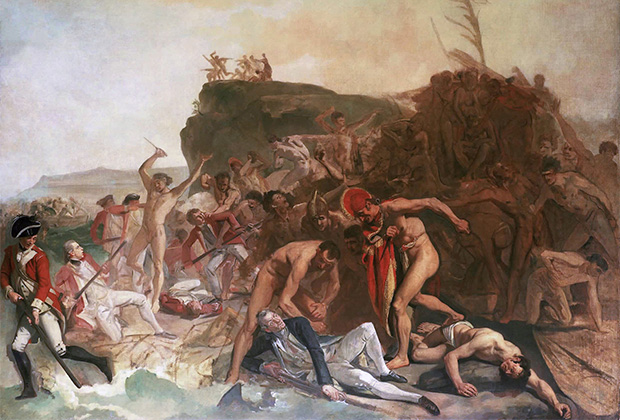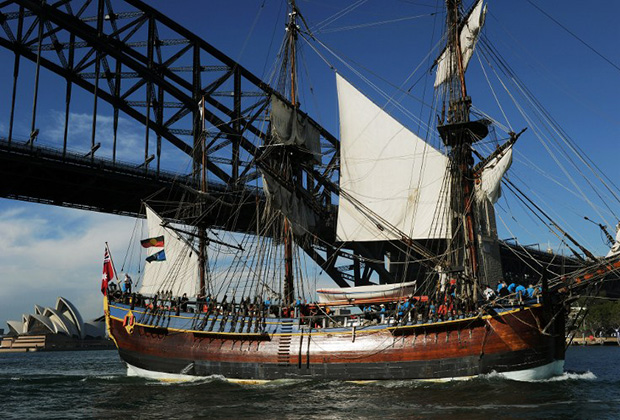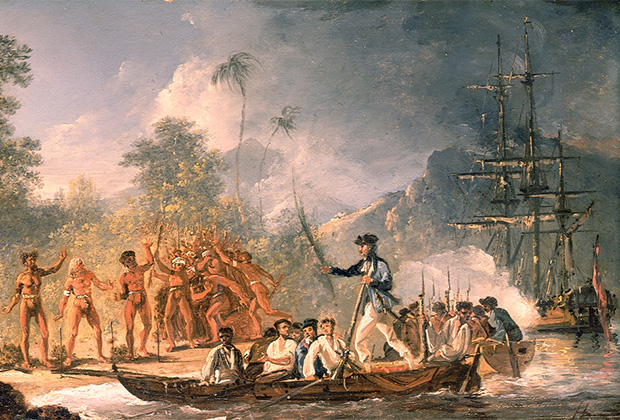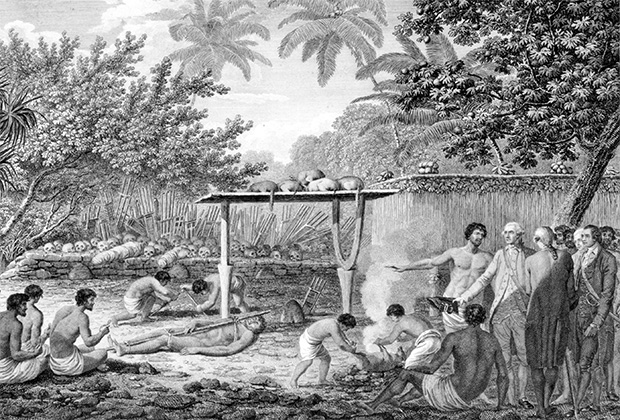Painting by George Carter "Death of Captain James Cook"
Envy, cowardice, pride and careerism ate the captain
On February 14, 1779, Captain James Cook (1728-1779), one of the greatest discoverers of new lands in the 18th century, was killed during an unexpected skirmish with the natives on the island of Hawaii. No one knows what really happened that morning in Kealakekua Bay. It is known, however, that the Hawaiians did not eat Cook, contrary to the famous song of Vysotsky: it was customary for the natives to bury especially important persons in a special way. The bones were buried in a secret place, and the meat was returned to the captain's “relatives”. Historians argue whether Hawaiians considered Cook to be a god (more precisely, the embodiment of the deity of abundance and agriculture Lono) or just an oversized stranger.
But we will talk about something else: how did the team even allow the death of their captain? How did envy, anger, pride, thieves, cowardice and passivity lead to a tragic coincidence? Fortunately (and unfortunately), more than 40 conflicting testimonies have survived about Cook's death: this does not provide an unambiguous explanation of the course of events, but it details the motives and motives of the team in detail. How the death of one captain blew up the ship's microcosm of the heroic navigators of the 18th century - in the historical investigation of Lenta.ru.
Clash with Hawaiians
The background is as follows: Cook's third circumnavigation of the world began in 1776. On the ships Resolution and Discovery, the British were to find the Northwest Passage: the waterway north of Canada connecting the Atlantic and Pacific Oceans. Having rounded South Africa, the sailors sailed to New Zealand and from there headed north, discovering the Hawaiian Islands along the way (in January 1778). Having regained strength, the expedition set off for Alaska and Chukotka, however, solid ice and the approaching winter forced Cook to return to Hawaii to anchorage (December-January 1779).
The Hawaiians greeted the British sailors very warmly. However, over time, the free treatment of local women and the overly active replenishment of water and food supplies caused discontent, and on February 4, Cook decided to prudently set the sails. Alas, that very night a storm damaged the Resolution's foremast and the ships returned to Kealakekua Bay. Openly hostile Hawaiians stole pincers from one of the ships: in revenge, the British hijacked a canoe, which, as a result of negotiations, refused to return.
Then on February 14, the longboat disappeared from the Resolution: and then Cook armed himself with a gun and, together with a detachment of ten Marines (led by Lieutenant Molesworth Phillips), demanded one of the local leaders to come to the ship (either as a hostage, or, more likely to negotiate in a calmer environment).
At first the leader agreed, then, yielding to the pleas of his wife, refused to go. Meanwhile, thousands of armed Hawaiians gathered on the shore and pushed Cook ashore. For some unclear reason, the crowd turned to action, and in the commotion that began, someone hit Cook on the back with a stick. The captain fired in revenge, but did not kill the Hawaiian - and then the natives rushed at the British from all sides.
Already in the water, Cook was stabbed in the back with a spear or a throwing dagger, and the captain (along with several sailors) died. Cook's body was dragged ashore, and the British retreated in disorder to the ships.

Death of Cook. 1790 engraving
After another fight, negotiations took place, which ended in peace: the Hawaiians solemnly returned Cook's body (in the form of pieces of meat), which infuriated the team. A mistake in intercultural communication (the British did not understand that the locals buried the captain with maximum dignity) caused a punitive raid: the coastal settlement was burned, the Hawaiians were killed, and as a result, the islanders returned the remaining parts of Cook's body, buried at sea on February 21. The position of the head of the expedition passed to the captain of the Discovery Charles Clerk, and when he died of tuberculosis near Kamchatka - to the second mate of the Resolution, James King.
Who's guilty?
But what really happened that morning in Kealakekua Bay? How was the fight in which Cook died?
First Mate James Burney writes: "Through binoculars we saw Captain Cook hit with a club and fall off a cliff into the water." Bernie was most likely standing on the deck of the Discovery. And here is what the captain of the ship Clark told about the death of Cook: “It was exactly 8 o'clock when we were alarmed by a gun salvo given by the people of Captain Cook, and strong cries of the Indians were heard. Through the telescope, I clearly saw that our people were running towards the boats, but who exactly was running, I could not make out in the confused crowd. "
The ships of the 18th century were not very spacious: the clerk was hardly far from Bernie, but he did not see individual people. What's the matter? The members of Cook's expedition left behind a huge number of texts: historians count 45 manuscripts of diaries, ship logs and notes, as well as 7 books printed in the 18th century.
But that's not all: the logbook of James King (the author of the official history of the third expedition) was accidentally found in government archives in the 1970s. And not all of the texts were written by members of the wardroom: the fascinating memoirs of the German Hans Zimmermann speak about the life of the sailors, and historians learned a lot from the plagiarized book of a dropout student John Ledyard, a Marine corporal.
So, 45 memoirs are told about the events of the morning of February 14, and the differences between them are not pure coincidence, the result of gaps in the memory of sailors trying to recreate the terrible events. What the British "saw with their own eyes" is dictated by a difficult relationship on the ship: envy, patronage and loyalty, personal ambitions, rumors and slander.
The memories themselves were written not only out of a desire to bask in the rays of Captain Cook's glory or to make money: the texts of the crew members are replete with innuendo, irritated hints of hiding the truth, and, in general, do not look like old friends' memories of a wonderful journey.

Death of Cook. Canvas by the Anglo-German artist Johann Zoffani (1795)
Tension in the crew had been accumulating for a long time: this was inevitable during a long voyage on cramped ships, an abundance of orders, the rationality of which was obvious only to the captain and his inner circle, and the expectation of inevitable hardships during the upcoming search for the Northwest Passage in circumpolar waters. However, the conflicts spilled over into an open form only once - with the participation of two heroes of the future drama in Kealakekua Bay: in Tahiti, a duel took place between Marine Lieutenant Phillips and the third assistant of the "Resolution" John Williamson. All that is known about the duel is that three bullets passed over the heads of its participants without causing any harm.
The character of both Irish was not sugar. Phillips, heroically injured by Hawaiian weapons (injured while retreating to the boats), ended his life as a London bum, playing cards on trifles and beating his wife. Williamson, on the other hand, was disliked by many of the officers. “This is a scoundrel who was hated and feared by his subordinates, who could not be tolerated by his peers and despised by his superiors,” one of the warrant officers wrote in his diary.
But the hatred of the crew fell on Williamson only after Cook's death: all eyewitnesses agree that at the very beginning of the collision, the captain gave some kind of signal to Williamson's people who were in the boats off the coast. What Cook wanted to express with this unknown gesture will forever remain a mystery. The lieutenant stated that he understood it as "Save yourself, swim away!" and gave the appropriate command.
Unfortunately for him, the rest of the officers were convinced that Cook was desperately calling for help. The sailors could provide fire support, drag the captain into the boat, or at least recapture the corpse from the Hawaiians ... There were a dozen officers and marines from both ships against Williamson. Phillips, according to Ledyard's recollection, was even ready to shoot the lieutenant on the spot.
Clark (the new captain) was immediately required to investigate. However, the main witnesses (we do not know who they are - most likely, the chiefs on the pinnacle and the skiff, who were also subordinate to Williamson off the coast) withdrew their testimony and accusations against the third assistant. Did they do it sincerely, not wanting to ruin the officer in a difficult and ambiguous situation? Or were they pressured by their superiors? We are unlikely to find out - the sources are very scarce. In 1779, while on his deathbed, Captain Clark destroyed all papers related to the investigation.
The only fact is that the leaders of the expedition (King and Clark) decided not to blame Williamson for the death of Cook. However, rumors immediately spread on the ships that Williamson had stolen documents from Clark's locker after the captain's death, or even earlier issued brandy to all Marines and sailors to keep silent about the lieutenant's cowardice upon returning to England.
It is impossible to confirm the truth of these rumors: but it is important that they circulated for the reason that Williamson not only escaped the tribunal, but also succeeded in every possible way. Already in 1779 he was promoted to the second, and then to the first mate. His successful career in the navy was interrupted only by the incident of 1797: as captain of the Agincourt, in the battle of Camperdown, he once again misinterpreted the signal (this time at sea), dodged an attack on enemy ships and went to court for default on duty. He died a year later.
In his diary, Clark describes what was happening to Cook on the shore according to Phillips: the whole story boils down to the misadventures of the wounded Marine, and not a word is said about the behavior of the other crew members. James King also showed favor with Williamson: in the official history of sailing, Cook's gesture was described as a matter of philanthropy: the captain de tried to keep his people from brutally shooting the hapless Hawaiians. Moreover, King places the blame for the tragic collision on Marine Corps Lieutenant Rickman, who shot the Hawaiian on the other side of the bay (which infuriated the natives).
It would seem that everything is clear: the authorities are covering up the obvious culprit of Cook's death - for some reason. And then, using his connections, he makes a stunning career. However, the situation is not so straightforward. It is curious that the team was divided into approximately equal numbers of Williamson's haters and defenders - and the composition of each group deserves close attention.
British Navy: hopes and disappointments
The officers of the Resolutions and Discovery were not at all happy about the great scientific significance of the expedition: most of them were ambitious young people who did not at all want to spend their best years on the sidelines in cramped cabins. In the 18th century, promotions were mainly given by wars: at the beginning of each conflict, the "demand" for officers increased - assistants were promoted to captains, warrant officers - to assistants. It is not surprising that the members of the team sailed longingly from Plymouth in 1776: literally before their very eyes, a conflict flared up with the American colonists, and they had four years to "rot" in a dubious search for the Northwest Passage.

By the standards of the 18th century, the British navy was a relatively democratic institution: people far from power, wealth and noble blood could serve and rise to command heights there. To find examples not far away, one can recall Cook himself, the son of a Scottish farm laborer, who began his marine life as a cabin boy at a coal brig.
However, one should not think that the system automatically selected the most worthy: the payment for relative democracy “at the entrance” was the dominant role of patronage. All officers built support networks, looked for loyal patrons in the team and in the Admiralty, earning a reputation for themselves. That is why the deaths of Cook and Clark meant that all contacts and agreements reached with the captains during the voyage went to dust.
Having reached Canton, the officers learned that the war with the rebellious colonies was in full swing, and all the ships were already manned. But before the disastrous (the Northwest Passage was not found, Cook died), no one cares much about the geographical expedition. “The crew felt how much they would lose in ranks and wealth, even deprived of the consolation that an old commander was taking her home, whose renowned merits could help the affairs of the last voyage to be heard and appreciated even in those turbulent times,” King writes in his journal (December 1779). In the 1780s, the war with Napoleon was still a long way off, and only a few were promoted. Many junior officers followed the example of warrant officer James Trevenin and went to serve in the Russian fleet (which, recall, in the 1780s fought against the Swedes and Turks).

In this regard, it is curious that the midshipmen and assistants of the master, who were at the very beginning of their career in the navy, spoke out loudest against Williamson. They missed their luck (the war with the American colonies), and even a single vacancy was quite a valuable prize. Williamson's title (third mate) did not yet give him much opportunity to take revenge on prosecutors, and his trial would create an excellent opportunity to remove a competitor. Combined with personal antipathy for Williamson, this more than explains why he was reviled and called the main villain that killed Cook. Meanwhile, many of the senior members of the team (Bernie, although he was a close friend of Phillips, draftsman William Ellis, First Assistant to Resolution John Gore, Discovery Master Thomas Edgar) did not find anything reprehensible in Williamson's actions.
For approximately the same reasons (career future), in the end, part of the blame was shifted to Rickman: he was much older than most of the members of the wardroom, began service as early as 1760, “missed” the beginning of the Seven Years War and did not receive a promotion in 16 years. That is, he did not have strong patrons in the fleet, and his age did not allow him to make friends with a company of young officers. As a result, Rickman was almost the only member of the team who did not receive any more titles at all.
In addition, by attacking Williamson, many officers, of course, tried to avoid uncomfortable questions: on the morning of February 14, many of them were on the island or in boats and could have acted more proactively after hearing shots, and retreating to ships without trying to repulse the bodies of the dead as well looks suspicious. Future Captain of the Bounty, William Bly (master on the Resolution), bluntly accused Phillips' Marines of fleeing the battlefield. The fact that 11 of the 17 Marines from the Resolution were subjected to corporal punishment during the voyage (by personal order of Cook) also makes you wonder how much they were willing to sacrifice their lives for the captain.

Landing at Tann. Painting by William Hodges. One of the characteristic episodes of contact between the British and the inhabitants of Oceania
But, one way or another, the authorities put an end to the proceedings: King and Clark made it clear that no one should be brought to court. Most likely, even if the trial of Williamson did not take place thanks to the influential patrons of the ambitious Irishman (even his longtime enemy Phillips refused to testify against him at the Admiralty - under the far-fetched pretext that he had a bad personal relationship with the accused), the captains preferred to make the Solomon decision ...
None of the surviving crew members should have become the scapegoat, guilty of the tragic death of the great captain: the circumstances, the vile natives and (as you can read between the lines of the memoirs) were to blame for the arrogance and recklessness of Cook himself, who hoped almost single-handedly to take the local hostage the leader. “There is good reason to suppose that the natives would not have gone so far if, unfortunately, Captain Cook had not fired at them: a few minutes before, they had begun to clear a path for the soldiers so that the latter could reach that place on the shore against which the boats were standing (I have already mentioned this), thus giving Captain Cook the opportunity to get away from them, "says the Clerk's diaries.
Now it becomes clearer why the Clerk and Bernie saw such different scenes through their telescopes. This was determined by the place in the complex system of "checks and balances", the status hierarchy and the struggle for a place in the sun, which went on board the ships of the scientific expedition. Seeing (or telling about) the death of the captain was prevented not so much by the “confused crowd” as by the officer’s desire to stay above the fight and ignore the evidence of guilt of individual crew members (many of whom were his protégés, and others - the protégés of his London bosses).

What is the meaning of what happened?
History is not just objective events that happened or did not happen. We know about the past only from the stories of the participants in these events, stories that are often fragmentary, confusing and contradicting each other. However, one should not draw a conclusion from this about the fundamental incompatibility of separate points of view, which supposedly represent autonomous and non-joining pictures of the world. Scientists, if not able to authoritatively state how "it really was", can find probable causes, common interests and other solid layers of reality behind the obvious chaos of "testimony".
This is what we tried to do - to unravel the net of motives a little, to discern the elements of the system that forced the team members to act, see and remember exactly this way, and not otherwise.
Personal relationships, career interests. But there is one more layer: the national-ethnic level. Cook's ships represented a cross section of imperial society: representatives of peoples and, most importantly, regions, to varying degrees remote from the metropolis (London), sailed there, in which all the main issues were resolved and the process of "civilizing" the British took place. Cornish and Scots, natives of the American colonies and the West Indies, Northern England and Ireland, Germans and Welsh ... Their relationship during and after the voyage, the influence of prejudice and stereotypes on what is happening, scientists have yet to understand.
But history is not a criminal investigation: least of all, I tried to finally identify the culprit in the death of Captain Cook: be it the “coward” Williamson, the “lack of initiative” sailors and marines on the shore, the “evil” natives or the “arrogant” navigator himself.
It would be naive to consider Cook's team a squad of heroes of science, “white people” in identical uniforms. It is a complex system of personal and professional relationships, with its own crises and conflict situations, passions and prudent actions. And by chance this structure explodes in dynamics with an event. The death of Cook confused all the cards for the expedition members, but made them burst into passionate, emotional notes and memoirs and, thus, shed light on relationships and patterns that, with a more favorable outcome of the voyage, would remain in the darkness of obscurity.
But the death of Captain Cook may turn out to be a useful lesson in the 21st century: often only similar extraordinary events (accident, death, explosion, escape, leakage) can manifest the internal structure and modus operandi of secret (or at least not advertising their principles) organizations whether it be the crew of a submarine or the diplomatic corps.




